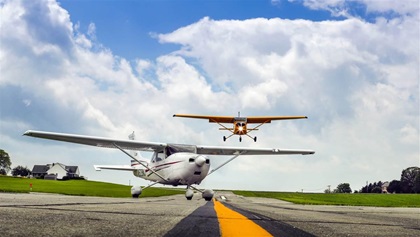PAC mentality
Safely fly a go-around with power, attitude, and configuration

Reasons to execute a go-around range from a hazard such as an aircraft on the runway to overshooting final approach (see “When In Doubt, Go Around,” sidebar). Pilots should adopt the mindset that a go-around/rejected landing is a normal maneuver and an alternative to nearly any approach and landing. Also, knowledge of energy management concepts is needed when flying this maneuver.
Rejected landings can be considered potentially dangerous only when delayed unduly and/or performed improperly. Delays in performing this maneuver appear to be the result of landing expectancy—for instance, a pilot perceives conditions on short final are not as threatening as they are and believes the approach and landing can be safely performed—and pilot ego or pride, such as the erroneous belief that going around for another landing is a display of failure and incompetence. As described in the Airplane Flying Handbook, to safely fly a go-around, perform three steps in the following order: power, attitude, and configuration. This correct sequence of steps may be remembered by the acronym PAC.
Power
Immediate application of full takeoff power is top priority for performing a go-around/rejected landing. Power adds energy to the airplane to increase kinetic energy (airspeed) and potential energy (altitude). Some mistakenly believe they should apply partial power, for example 75 percent; this is not correct. The descending inertia of a landing airplane must be overcome before it descends to the ground. To do this, appropriate kinetic energy must be promptly restored and increased for the airplane to climb and turn safely away; this can best be accomplished by smoothly applying full power.
Attitude
Because of increased elevator pitch-trim setting employed on final approach, application of full power can result in the airplane’s abruptly pitching up, increasing the angle of attack (AOA). In this situation the pilot may need to apply appropriate forward stick or yoke pressure to prevent kinetic energy (airspeed) from eroding precipitously and exceeding critical AOA and stalling, leading to an inflight loss of control stall-spin accident. Elevator trim needs to be reset as soon as possible following application of full power to keep from exceeding the critical AOA. In addition, a sudden nose-up attitude predisposes the airplane to yaw to the left because of asymmetric propeller loading (P-factor). If the airplane stalls and yaws, it will spin. Appropriate right rudder pressure must be applied immediately to counteract asymmetric propeller loading and torque (rotational force). Pitch attitude should initially be set to a near level to allow kinetic energy to increase from final approach airspeed (generally 1.3 times stalling speed in the landing configuration) to best rate of climb airspeed (VY). Subsequently, pitch attitude should be regulated to maintain VY and safely climb away.

Configuration
Drag (parasite and induced drag) depletes energy from the airplane. Because the priorities are to increase kinetic and potential energy immediately, parasite drag from flaps and landing gear need to be eliminated. Flaps must be raised from the full flap setting to the climb flap setting and the landing gear needs to be retracted (if retractable). Caution: A sudden and complete retraction of the flaps can result in loss of lift, resulting in the airplane descending into the ground. The Airplane Flying Handbook recommends that unless otherwise specified in the airplane’s pilot’s operating handbook, flaps should be retracted partially before retracting the landing gear for two reasons: For many airplanes full flaps result in more drag (energy depletion) than the landing gear, and should the airplane inadvertently touch down as the rejected landing is initiated, it is preferable to have the landing gear down. After a positive rate of climb is established, the landing gear can be retracted. Subsequently, the remaining flaps can be fully retracted.
A go-around/rejected landing must be understood as a possible maneuver of any flight, despite the fact that it’s not used for every landing. Pilots need to train the way they fly, and regardless of their certificate level, pilots should regularly train to correctly fly a go-around to remain sharp for what could happen.
Michael J. Banner, is a CFI and MEI, courtesy professor at the University of Florida in Gainesville, and check pilot and instructor pilot with the rank of major in the Civil Air Patrol. He has 5,500 hours flight time and owns a 7GCBC Citabria.
 When in doubt, go around
When in doubt, go around

